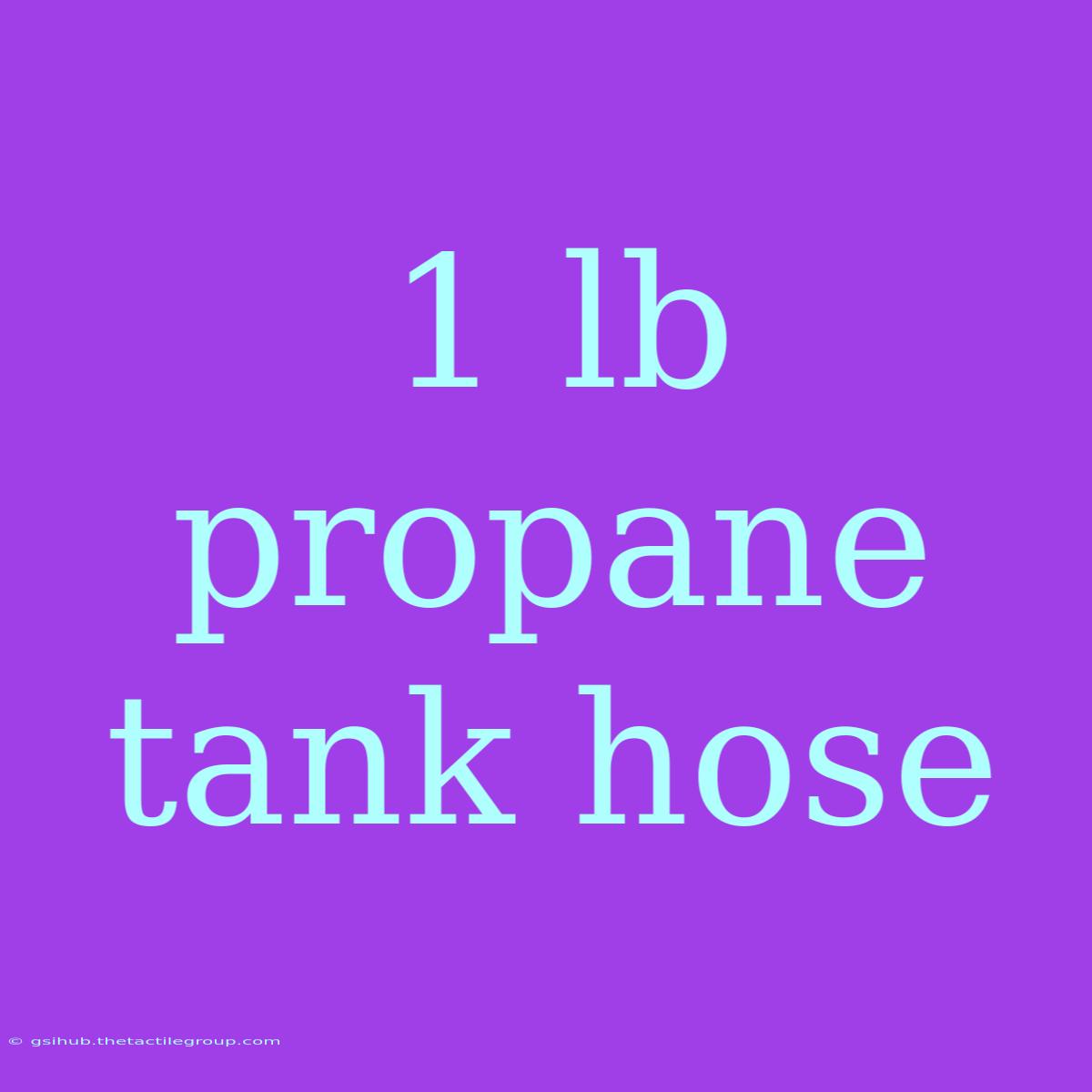1 lb Propane Tank Hose: A Comprehensive Guide
Hook: Is a 1 lb propane tank hose as simple as it seems? The truth is, understanding the nuances of this seemingly basic component is crucial for safe and efficient propane use. The right 1 lb propane tank hose selection ensures safety and optimal performance for your propane appliances.
Editor's Note: This comprehensive guide on 1 lb propane tank hoses was published today to help users choose and use them safely. We've compiled essential information for safe and effective propane usage.
Understanding 1 lb propane tank hoses is critical for safety and proper functioning of your propane equipment. This guide delves into their construction, compatibility, safety considerations, and maintenance, providing a complete overview to help you make informed decisions. Improper hose selection or usage can lead to leaks, fires, and other hazards.
Analysis: This guide compiles information from various sources, including manufacturer specifications, safety regulations, and industry best practices. We've analyzed numerous product listings and user reviews to provide a balanced perspective on 1 lb propane tank hoses, addressing common concerns and misconceptions.
| Aspek Kunci Hose Tangki Propana 1 lb | Penjelasan |
|---|---|
| Jenis Hose | Karet, PVC, atau komposit. |
| Panjang Hose | Beragam, pilih panjang yang sesuai kebutuhan. |
| Tekanan Kerja | Sesuai dengan spesifikasi regulator dan peralatan. |
| Konektor | Pastikan kompatibilitas dengan tangki dan peralatan. |
| Keamanan | Periksa secara berkala terhadap kebocoran dan keausan. |
Subheading: 1 lb Propane Tank Hose
Introduction: Selecting the appropriate 1 lb propane tank hose is paramount for safe and effective operation of portable propane appliances. This section explores crucial aspects influencing hose selection and maintenance.
Key Aspects:
- Hose Material: Durability, flexibility, and resistance to chemicals.
- Hose Length: Sufficiency to reach appliance without strain or tangling.
- Connector Type: Compatibility with both tank and appliance fittings.
- Pressure Rating: Ensuring appropriate pressure handling capacity.
- Safety Features: Leak detection and prevention mechanisms.
Subheading: Hose Material
Introduction: The material of a 1 lb propane tank hose significantly impacts its lifespan, flexibility, and resistance to environmental factors. Understanding the properties of different materials is crucial for selecting a durable and safe hose.
Facets:
- Rubber Hoses: Traditional, flexible, but susceptible to cracking and deterioration over time.
- PVC Hoses: More resistant to chemicals, less flexible than rubber.
- Composite Hoses: Often a blend offering durability and flexibility, potentially higher cost.
Summary: The choice of hose material depends on the application and environmental conditions. Factors such as exposure to sunlight, chemicals, and temperature variations should influence the decision. A durable hose ensures safe and reliable operation.
Subheading: Hose Length and Connector Type
Introduction: The length of the hose and the type of connectors directly affect usability and compatibility with propane equipment. Careful selection ensures safe and convenient operation.
Further Analysis: Choosing a hose that is too short can cause strain and potential damage, whereas an excessively long hose increases the risk of entanglement and accidental damage. Ensuring compatibility between the hose connectors and the tank and appliance valves is non-negotiable for safety.
Closing: Correct hose length and connector selection are critical for safety and usability. Matching connectors to appliances and tanks prevents leaks and ensures a secure connection. Incorrect connectors are a serious safety hazard.
Information Table:
| Hose Material | Flexibility | Chemical Resistance | Durability | Cost |
|---|---|---|---|---|
| Rubber | High | Low | Moderate | Low |
| PVC | Low | High | High | Moderate |
| Composite | Moderate | Moderate | High | High |
Subheading: FAQ
Introduction: This section addresses frequently asked questions about 1 lb propane tank hoses.
Questions:
- Q: How often should I inspect my propane hose? A: Inspect before each use for cracks, kinks, or damage.
- Q: Can I use any propane hose with a 1 lb tank? A: No, ensure compatibility of connectors.
- Q: What should I do if I detect a propane leak? A: Immediately turn off the propane tank valve, ventilate the area, and seek professional assistance.
- Q: How long do propane hoses last? A: Varies based on material and usage, but regular inspection is crucial.
- Q: Can I repair a damaged propane hose? A: No, replace a damaged hose immediately. Never attempt repairs.
- Q: What are the safety precautions when using a 1 lb propane tank? A: Always follow manufacturer instructions. Proper ventilation is vital.
Summary: Regularly inspect your hose for damage, and immediately replace any damaged or worn hose.
Subheading: Tips for 1 lb Propane Tank Hose Usage
Introduction: These tips provide guidance for the safe and effective use of 1 lb propane tank hoses.
Tips:
- Always inspect the hose before each use.
- Never force connections.
- Store the hose in a cool, dry place away from direct sunlight.
- Avoid kinking or bending the hose excessively.
- Regularly check for leaks using soapy water.
- Replace the hose if damaged or showing signs of wear.
Summary: Following these simple tips ensures the safe and prolonged use of your 1 lb propane tank hose.
Summary of 1 lb Propane Tank Hose Information
This guide has comprehensively explored the critical aspects of selecting and maintaining 1 lb propane tank hoses. The choice of material, length, and connectors are crucial considerations for safe and efficient operation. Regular inspection and immediate replacement of damaged hoses are paramount for safety.
Closing Message: Prioritizing safety when using propane is non-negotiable. By carefully following the guidelines outlined in this guide, users can ensure the safe and effective operation of their propane appliances. Regular inspections and preventative maintenance are key to preventing accidents and ensuring reliable service.

